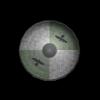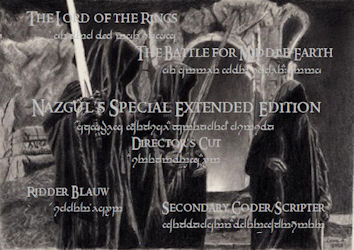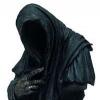¤¤¤¤¤¤¤¤¤¤¤¤¤¤¤¤¤¤¤¤¤¤¤¤¤¤¤
SEE - Siege Weaponry & Monsters
¤¤¤¤¤¤¤¤¤¤¤¤¤¤¤¤¤¤¤¤¤¤¤¤¤¤¤
Introduction
Siege weapons and monsters have always played an immensely important role in the BFME series, SEE in particular... although I was never fully satisfied by how it was all set up, there are a number of things that bother me concerning the destruction of an enemy base: why would it help to start swinging swords at a structure, stone or otherwise? Next up: why would you even bother shooting arrows at a structure? I can understand that it would help to have them be flaming arrows, but come on? There is like one or two faction in BFME that has wooden structures, plus with the new flaming arrows approach why even bother? What I could do with a siege weapon or monster could be matched with little more than one peasant horde... it was annoying. Therefore I have decided to show my ideal approach to sieges in SEE, please remember this is my opinion and is no way backed up by either Nazgûl or the SEE team.
DISCLAIMER: NOT ALL CONCERNS LISTED ABOVE APPLY TO SEE!
Chapter I: Structures
I've decided to start off with the structures, as I don't think starting with anything else could be justified. After all how can you talk about what you'll use to destroy structures when you haven't even talked about those. I must confess though, I can say with near certainty that some of the points listed below have been said to be my Nazgûl himself, I have added my own twist to it though.
Structures should be unattackable by anything but siege weaponry or monsters (trolls, giants, eagles and fellbeasts), and their health, like in BETA 4.7 should be quite high ranging from the lowest health for the resource structures to the highest health for the fortresses.
Also I propose that each and every structure in SEE is put under one of the following groups, each with one armor set:
I come to my conclusion on structures, stating my ideals above.Structure Armor Categories
- (1) Cloth (Harad), the weakest of structures, are perhaps by far the ones made up of tents, although here you could justify having units be able to attack it, and suggest not to do so due to balancing issues, unless you can find a solution to those. They are extremely vulnerable to both siege weaponry and monsters.
- (2) Wood (Rohan, Rhûn), quite weak though significantly stronger than cloth structures, they are quite vulnerable to both siege weaponry and monsters.
- (3) Rock/Earth/Stone Basic/Wood (Moria, Mordor, Lothlórien), the following structures have average armor, and provide decent protection against both siege weaponary and monsters.
- (4) Stone/Iron (Gondor, Isengard), above average, they provide great protection to both siege weaponry and monsters, although siege weaponry will remain at the upper hand compared to monsters.
- (5) Stone Advanced (Erebor), masters of stonework, the dwarves of Erebor, construct structures of exceptional qualities, not quickly torn down by both siege weaponary and monsters, both tactic and heavy siege weaponary will be required to take down there majestic structures.
Chapter II: Monsters
As you will have read above, few monsters will also be applicable to use during sieges: trolls, giants, eagles and fellbeasts.
Trolls < Eagles < Fellbeasts < Giants
Italic = Applies towards rock throwing trolls!
As you can see above I have listed the order in which I rank their effectiveness against various structures, my reasoning for this is as following: although I believe both Eagles and Trolls have proven to posses amazing feats of strength, they will not be as effective against the defense of a well built structure. Fellbeasts came up next, earning their spot by their acts during the siege of Minas Tirith in which they aided immensely in ensuring it's capture. Lastly is the giants, they are of immense size and posses immense strength: weak structures like those of Harad, Rhûn or Rohan would not survive longer than a few moments against its power; Isengard, Gondor and Erebor however will take a while longer to take down, and I therefore would not charge at them with an army of Giants.
And so this chapter too draws to a conclusion, up next battering rams!
Chapter III: Battering Rams
This chapter concerns all battering rams, besides those of Isengard and Erebor.
A battering ram is a siege engine originating in ancient times and designed to break open the masonry walls of fortifications or splinter their wooden gates...
...Rams proved effective weapons of war because old fashioned wall-building materials such as stone and brick were weak in tension, and therefore prone to cracking when impacted with sufficient force. With repeated blows, the cracks would grow steadily until a hole was created. Eventually, a breach would appear in the fabric of the wall—enabling armed attackers to force their way through the gap and engage the inhabitants of the citadel.
As quoted above, battering rams seem effective especially when breaking open either walls or gates, proving most effective to the latter. Against structures it would probably be less effective, pointing towards the more obvious choice: catapults, trebuchets and their counterparts...
I wouldn't even waste a ram on the haradrim structures, as I don't really see how that would work out: although for the sake of balance don't make them go down on the first shot: perhaps the third would be more suitable. The other types of structures would probably prove more of a challenge, with their resistance rising exponentially, making them nearly useless towards dwarven craftsmanship.
To sum it all up, ideal during early game, use your rams to weaken the enemies defenses early, later use them to break open their gates and perhaps walls; but don't waste them trying to destroy a fortress.
Chapter IV: Ranged Siege Weaponry
This chapter concerns catapults and such sorts of all factions, besides Erebor and Isengard, as I'll be talking about them later. Ranged siege weaponry should function as an irreplaceable tool during both mid- and endgame, tearing down many structures with relative ease... Once again the resistance to ranged siege weaponry should rise exponentially, although they should remain useful to the very strongest of structures.
That as much wraps it up for ranged siege weaponry, only one more part remains, Erebor and Isengard.
Chapter V: Erebor and Isengard's Advanced Siege Weaponry
Much of what I've said before applies to both of these factions, there's only one key difference: Erebor and Isengard have a more various range siege weaponry, deadly siege weaponry.
Erebor, housing the masters of craftsmanship, can tear most structures down in a blink. Their siege weaponry has the highest accuracy of all, and rarely misses. Their array of siege weaponry is also cheaper than the other factions, granting them a bonus especially useful during early game.
Isengard on the other hand handles things differently, they are not scared of losing some accuracy for firepower, even if it results in allied casualties. Deadly, explosive and expensive siege weaponry is their advantage, often resulting in devastating consequences.
Conclusion
I hope you enjoyed reading what I have said above! I may expand upon this if I have the time and motivation, please don't forget to comment!
Edited by Ridder Blauw, 10 October 2011 - 04:18 PM.
























